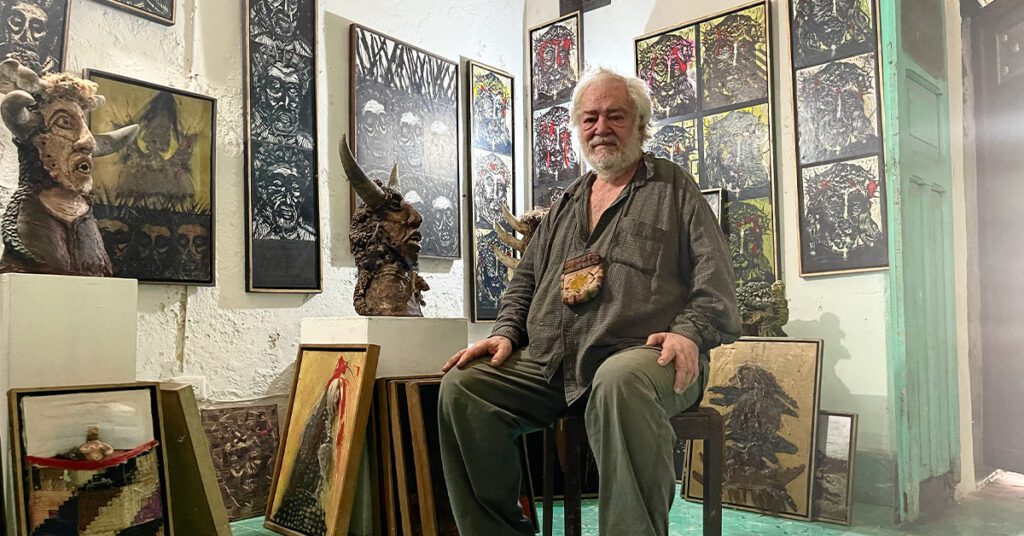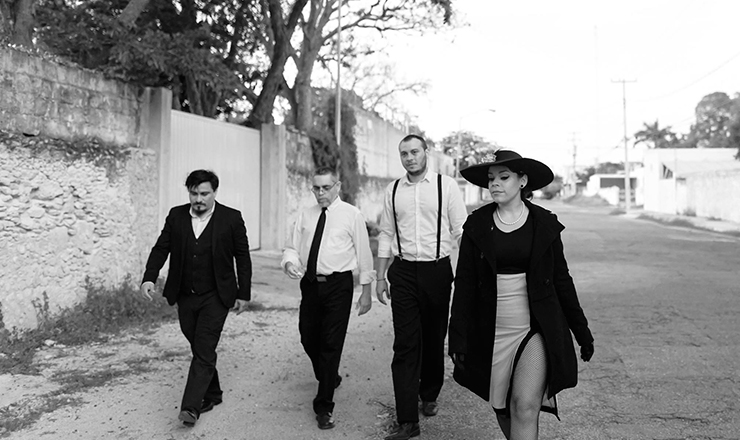As you walk into Joseph Kurhajec’s Merida Museum of Fine Art, you enter a striking and powerful wonderland of mysterious and ancestral forces reflected in sculptures, etchings, paintings and carvings. His imagination dives into the depths of tribal fetish, cultural folklore, death, and the supernatural. It’s a dreamland of life’s enigma, the invisible line between the natural, and the spiritual world. He arrived back in Merida in January 2023 for what he nostalgically tells me will be his last trip here. He has lived a brilliant life of art, travels and experiences and his imaginative artwork is a profound reflection of his passion for life, culture, religion and the unknown.
















“I believe we learn to make sculpture by making sculpture. Every sculpture is the creation of a dedicated precise set of acts, physical or intellectual, from which comes the form of achievement, a satisfaction of the spirit. One becomes in some way a tool in the hand of God. I continue to search in every sculpture for some act of vision, of faith, of desires.
Art is eternal: for it reveals the inner landscape which is the soul of the man. Let the works speak for themselves.”
What is art to you?
“My reason for being.”


Early Influences
Joseph was raised in a Catholic family in Wisconsin. They attended San Sebastian’s Church and as a child he remembers being impacted by the bloody Christ on the cross and paintings of Saint Sebastian tied to a post and shot with arrows. As an adolescent, he visited the Field Museum in Chicago and saw a show of Congo nail fetishes. This exhibition reminded him of Saint Sebastian and Christ on the crucifix and he recalls thinking:
“the fetish pieces are power pieces, the most powerful pieces made on the planet”.
He had found his calling in art, to create compelling pieces that would provoke the imagination and reflect the profound intensity that surrounds us all in this world and the next.
Kurhajec in Mexico
He discovered his talent for sculpture at an early age and works in many mediums including wood, stone, steel, ceramic, leather and fur. In 1961 he took a bus from Chicago to Isla Mujeres. From there he explored Mexico and went to the Museum of Anthropology in Mexico City where he saw the Pre-Columbian stone work of Olmecs, the Maya and the Aztecs which piqued his interest to work with stone. His first work here in Mexico was in stone and then ceramics where he worked with ceramic artisans from Tikul, Yucatan. For ten years he returned every winter to his house and gallery in Merida and carved stone and made ceramics. According to Joseph, his art is a work of passion, not of decoration.










New York City Art Scene
He lived in NY from 1963 to 1971 where he ran in the same circles as Andy Warhol, Frank Stella and other popular artists who are creating what we know today as pop art. His art is labeled Art Brut, and he is seen as an “independent” artist. He worked with the welder Seymour Lipton and taught Salvatore Scarpitta how to weld. And was good friends with Leon Golub. During his time in New York, he created fascinating sculptures that he wrapped in materials such as leather, rope and fur. In 1963, he presented an exhibition at the Allan Stone Gallery of his wrapped sculptures. Christo Vladimirov Javacheff visited his exhibition and was inspired by his work.




















Photos by Sergio Kurhajec
After New York Paragraph
Passions
Joseph formed part of the anti-war and black liberation movement. He protested the World War, Korean War, Vietnam, Iraq and most recently the war in Ukraine. He is an activist and was on the ground floor of the revolutionary movement. His passion for justice is reflected in powerful works such as the ceramic missiles with skulls on the top.
He loves fishing. He finds peace and tranquility in nature and running water.








Photos by Sergio Kurhajec
Throughout his life he has taught workshops and presented exhibitions in galleries and museums in Iceland, Ireland, England, Norway, Finland,Czech Republic, Slovakia, Spain, Italy and France. Each country inspires his work differently. In New York he sculptured in ceramics and metal, in Mexico he carved in the beautiful stone used for thousands of years in indigenous art, and in France the grand Cathedrals feed his imagination he does mostly etchings.
Today he mostly dedicates his time to painting because he doesn’t have the strength to sculpt. He works on anti-war paintings in support of Ukraine.
Galleries, Museum and Workshops:
- Guggenheim Museum in 1971 “10 Independents” with ten other “independent” artists, including Red Grooms, Nancy Grossman and H.C. Westermann.
- Whitney Museum 1964 “Young America”
- The Whitney Biennial 1965
- Sculpture exhibited for Vera List at the New School in New York
- Throughout his life he has done workshops and exhibitions in Iceland, Ireland and English and Norway, Finland,Czech Republic, Slovakia, Spain, Italy and France teaching sculpture and exhibiting his art in galleries and museums.






kurhajec has walked in many important and inspiring places. His work is a brilliant legacy. A documentary awaiting a maker. Thx to MidcityBeat for a great article. Many more circles around old el sol Joseph!
Loved the article I have one of his very early work reading this it was probably done in Mexico it’s dated 1962 Thankyou so much billy
Joseph, Found this site on my random search for the name name of the artist who sculped the lovely lady in our house. You always said a friend of a fiend. I never believed you.
Jane Dwyer Walrath